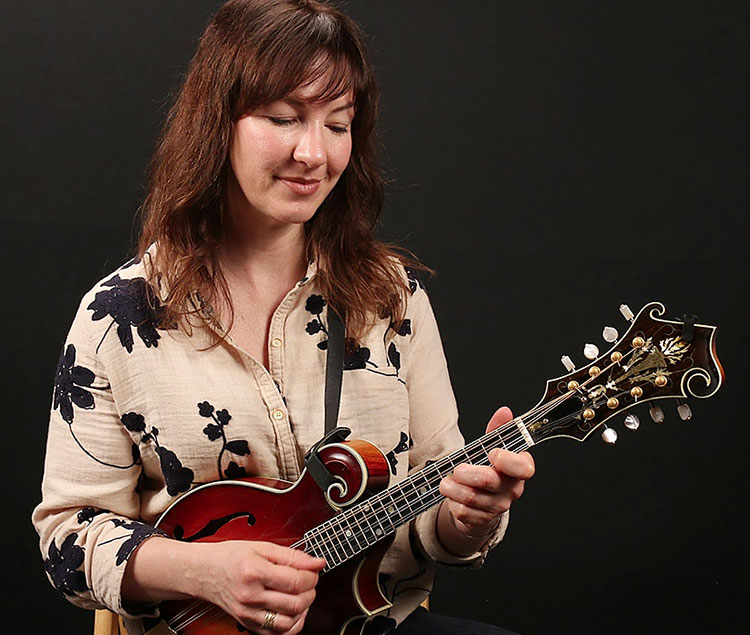In the second part of this lesson, Sharon shows you how to play through the neighborhoods on the song “Your Love Is Like a Flower” and shows you how and when to add the seventh to the inversions.

Sharon Gilchrist’s Creative Mandolin Backup course is designed for mandolinists who want to develop their rhythm and backup beyond the basic mandolin chord forms and chop or boom-chick rhythm. Mandolinists often concentrate most of their practice time on building repertoire and learning to play great solos, but when playing with other people, whatever the style of music, the amount of time mandolinists spend playing solos is much less than the amount of time they spend playing backup.
In this course, Sharon shows you how to use just a few simple, easy-to-grasp concepts that will help you vary your backup playing. These concepts will allow you to improvise and respond to the instrumentalists and/or singers you’re playing with. She talks about playing chords in different registers of the mandolin, adding sevenths to a chord when you want to move in a certain direction, creating walking lines with double stops and chords, varying your rhythm patterns, accenting the ends of verses or different parts of a tune, and more. These concepts allow you to be more engaged the entire time you’re playing and contribute more to the overall sound of the music, which will make the entire experience of playing with other people more dynamic, alive, and fun.
You’ll learn about chord inversions and the three different inversions you can use for each chord, so you can play the same chord in lower, medium, or higher registers, and you’ll learn to play chord inversions as double stops or three-note closed chords that can be moved around the neck. You’ll apply these inversions to a variety of chord progressions, starting with a basic I–IV–V progression and then adding minor chords and seventh chords for more complex chord progressions.
Sharon Gilchrist’s Creative Mandolin Backup course is designed for intermediate-level mandolinists who want to develop their rhythm and backup beyond the basic mandolin chord forms and chop or boom-chick rhythm. With easy-to-grasp applied-theory concepts and instruction in using chord inversions. In this video, Sharon talks about what she’ll be teaching in Creative Mandolin Backup.
Check out these lessons from Sharon’s Beginning Mandolin course before moving on to the other lessons in Creative Mandolin Backup if you’re unfamiliar with basic open and chop chord (Monroe chord) forms on the mandolin.
In this lesson you’ll get a complete overview of basic open chord shapes, some of which can be played with just two fingers. Sharon shows you the open chord family and then a 4/4 rhythm pattern in which you play the lowest note of each chord and follow it with a strum of the higher strings. You can use this pattern to practice playing any of the open chords you’ve learned. She also gives you some advice and simple exercises to help you practice changing chords.
The closed “chop” chords known as “Monroe chords” (after Bill Monroe) are what give your rhythm mandolin that classic bluegrass chop sound or bark. Sharon shows you the Monroe chord shapes for G and C, but since they’re closed chords (with no open strings) you can move these shapes around the neck to play any major chord.
In this first lesson in Creative Mandolin Backup, Sharon lays the groundwork for the rest of the course, focusing on finding and playing major triads and their chord inversions. She explains how to take the root chord positions and move each note up (or down) the neck to find the next available chord tone to create the 1st and 2nd inversions. She then shows us how to use those inversions in chord “neighborhoods,” and uses the classic bluegrass tune "Your Love Is Like a Flower" as an example to illustrate how to use inversions. Sharon also talks about playing with the correct left-hand position.
In this lesson, Sharon shows you how to play through the “Your Love Is Like a Flower” chord progression in all the neighborhoods and how to move between neighborhoods. You’ll also learn how and when to add the seventh to the three major chord inversions.
Sharon gives you more experience using chord inversion neighborhoods. She starts by talking about some musical terminology that can be confusing and then goes on to show you the chord inversions in the key of G, which will allow you to play in the key of D (the I–IV–V chords in the key of D, are D, G, and A).
Sharon shows you how to create melodic phrasing and dynamics on the fiddle tunes “Angeline the Baker” and “Gold Rush” using different neighborhoods and a variety of rhythmic figures.
Sharon ventures into minor chord and minor key territory. She introduces the vi minor chord and shows you how to use the chord inversion neighborhoods to backup chord progressions that include vi minor chords, including “Cherokee Shuffle” in the key of A, “Big Sciota” in the key of G, and “Billy in the Lowground” in the key of C. She also shows you how to play inversions in a minor key using the song “Wayfaring Stranger.”
Sharon shows you how to use many of the things she’s talked about in this workshop on some specific tunes. She also introduces you to the Mixolydian mode, which uses the bVII chord, and shows you how to use the inversions and neighborhoods on tunes in the Mixolydian mode, including “Old Joe Clark,” “June Apple,” and “Salt Creek.” She also talks about using passing chords, with “St. Anne’s Reel” and “Blues Stay Away from Me” as examples.